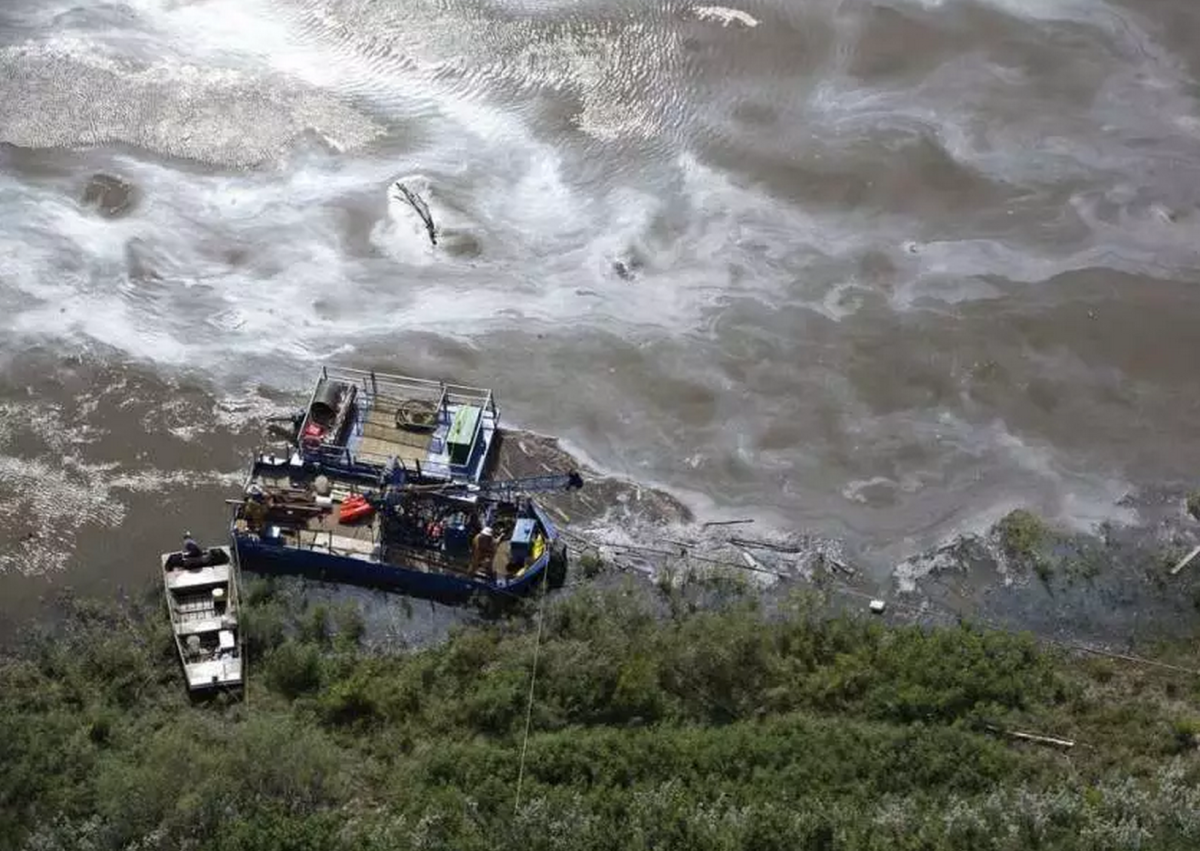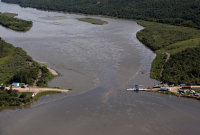Support strong Canadian climate journalism for 2025
The reality of the disastrous Husky oil spill in Saskatchewan is finally starting to sink in — quite literally.
The wildlife death toll has now risen to 58 birds, fish, and other species. Roughly 133,000 litres of oil and other materials has already been recovered, but globs of oil continue to sink to the bottom of the North Saskatchewan River, complicating the clean up effort.
The challenges prompted the province's Ministry of Environment on Tuesday to announce that it was "unlikely" clean up crews would ever be able to contain all of the oil from the pipeline leak.
"To be very frank, [the odds are] low," Ash Olesen, the ministry's manager of potash and central operations, told reporters at a media conference. "It's unlikely we'll recover all of it and I can't provide an estimate as to how much."
More than 1,200 water samples have been collected from the spill since it began nearly two weeks ago at a Husky Energy pipeline near Maidstone, Sask. The pipeline, built in 1997, leaked up to 250,000 litres — or 1,572 barrels — of oil and other toxins into the major waterway, forcing nearby municipalities to enact emergency water restrictions and shut down their water treatment plants.
Olesen said interim findings of at least 256 sample results will be shared with impacted communities later on Tuesday and made public Wednesday. In the meantime, both Prince Albert and North Battleford — the two cities whose water supplies were immediately contaminated — have been successfully operating on reserves and building temporary pipelines to alternate water sources.

Could the spill have been prevented?
While the cause of the leak remains under investigation, a former oil and gas industry engineer, Evan Vokes, believes it's possible that the catastrophic leak could have been prevented had Saskatchewan not skipped out on a crucial review of new pipeline infrastructure located near the site of the spill.
In 2014, the Ministry of Environment opted out of an environmental impact assessment (EIA) for a 23-kilometre expansion to Husky's Saskatchewan Gathering System, which connects to the old pipeline responsible for the disaster. A CBC article published last week revealed that the leak began shortly after the company restarted the flow of oil through that system.
If an EIA had been conducted on the new pipeline years ago, Vokes, a former engineer with TransCanada, said that the old pipeline might have been flagged as an integrity risk, prompting upgrades or repairs that would have allowed Husky to avert the disaster.
“If you don’t do an environmental assessment no one accounts for what happens when it goes wrong," Vokes told National Observer. "That pipeline should have been flagged as an integrity assessment from the learnings of the new pipeline.”
Emily Eaton, a University of Regina geography professor who has been studying the impacts of oil development on Saskatchewan communities, confirmed that Vokes' theory is possible, but emphasized that because the cause of the leak remains unknown, it really is a shot in the dark.
"Whether that would have resulted in a recommendation to replace it, or assess its integrity more thoroughly and thus avoid a spill is a guessing game," she said. “I haven’t seen necessarily anything that shows that Husky is more negligent than any other company, I just think the regulatory environment is so lax."
Saskatchewan's environmental assessments too lax
Despite the fact that it would run beneath a major waterway, the 23-kilometre expansion was excused from an EIA in 2014 as it was not considered a "development" by the Ministry of Environment. According to Eaton, this is typical of the government, which "gives a pass" to nearly all pipelines its regulates.
“They’re always considered 'not a development' and therefore don’t go to an EIA," she explained. "So I don’t think there’s anything particularly spectacular about this spill, it’s just the result of a regulatory system that is particularly lax.”
Vokes, best known as the engineer who blew the whistle on TransCanada in 2012, agreed and said the engineers who built the pipelines — new and old — clearly didn't do their jobs. Husky could not tell National Observer how close the new pipeline infrastructure was to the leak in kilometres, and would not answer repeated questions on whether the pipeline near Maidstone that spilled the oil was reviewed or assessed as part of the system when the new expansion was built.
Vokes was suspicious about the lack of transparency.
"I think you’re on the right track if they won’t answer that question," he said. “What you’re seeing is politics in engineering, and politics and engineering don’t mix.”
Husky has already disclosed that it knew something was amiss with the pipeline that leaked on the eve of Wed. July 20, but did not report the spill to the government until 14 hours later on Thurs. July 21. Husky was not available to answer reporter questions at the media conference on Tuesday morning, but when presented with Vokes' theory by National Observer over the phone, Olesen of the Ministry of Environment responded:
"Hindsight is 2020. I can neither deny or confirm the accuracy of those statements."

Not an acceptable answer
Clean up efforts for the spill continue today as Husky Energy, the Ministry of Environment, Environment and Climate Change Canada, and other experts wash the shorelines of the North Saskatchewan River. Approximately seven kilometres of shoreline has been cleaned so far, and 11 booms remain in place to contain the floating oil.
Nature Canada however, has deemed the province's Tuesday statement that full containment is unlikely, as "not an acceptable answer" at all. Floating oil is indeed difficult to contain, said its director of conservation and general counsel, Stephen Hazell, but "that's their problem."
"That’s what they have insurance for," he told National Observer. "It’s no answer to say, ‘Oh it’s sunk to the bottom, we can’t get at it.’ Put some smart engineers on it and figure it out.”
He too, called Saskatchewan's environmental assessment regime for pipelines "among the worst" in Canada, and called on the government and Husky Energy to provide whatever resources are required to dig the sunken oil out from the bottom of the river.
Husky Energy has issued a public apology for the spill.






Comments
Frankly, a public apology by Husky oil is virtually meaningless.
What Saskatchewan’s lax regulatory regime proves is the fact that companies do not do what they may know to be safe practices, they do with their required to do and only if there watched closely. In making proposals, pipelines always talk about the state-of-the-art equipment. Then they go out in buy pipe and other materials on the cheap. They monitor as closely as they are forced to do and that is about it.
In Husky’s case, the company should forfeit its after-tax profits until the cost of a total cleanup is paid for.
Voters in Saskatchewan, and particularly in the affected areas, should reflect on their voting the next time there is an election. They may want to take into account the fact that Brad Wall doesn’t really believe in environmental stewardship just like he doesn’t believe in serious action on climate change.
Frankly, a public apology by Husky oil is virtually meaningless.
What Saskatchewan’s lax regulatory regime proves is the fact that companies do not do what they may know to be safe practices, they do with their required to do and only if there watched closely. In making proposals, pipelines always talk about the state-of-the-art equipment. Then they go out in buy pipe and other materials on the cheap. They monitor as closely as they are forced to do and that is about it.
In Husky’s case, the company should forfeit its after-tax profits until the cost of a total cleanup is paid for.
Voters in Saskatchewan, and particularly in the affected areas, should reflect on their voting the next time there is an election. They may want to take into account the fact that Brad Wall doesn’t really believe in environmental stewardship just like he doesn’t believe in serious action on climate change.
The oil industry continues to avoid its responsibility to the citizens and to the environment. Even with this spill the industry and Premier Brad Wall will separate the two issues--first we sort the problem of oil spill in the North Saskatchewan River, then we take up the issue of new pipelines. Don't they see that the two are absolutely inseparable. We the public ought to use this as a one big reason for denying any more pipelines. The industry has shown it is incapable of regulating the oil industry, and preventing such accidents. The people downstream from the oil spill are now paying the price.
The oil industry continues to avoid its responsibility to the citizens and to the environment. Even with this spill the industry and Premier Brad Wall will separate the two issues--first we sort the problem of oil spill in the North Saskatchewan River, then we take up the issue of new pipelines. Don't they see that the two are absolutely inseparable. We the public ought to use this as a one big reason for denying any more pipelines. The industry has shown it is incapable of regulating the oil industry, and preventing such accidents. The people downstream from the oil spill are now paying the price.
OXYMORONS:
Smart - Pipeline Engineer
Dilbit - Floats
Pipeline Companies - Transparency
National Energy Board - Independent Regulator
Thank you National Observer for this story.Other media sources seem to be ducking the main story "The Spill" Their coverage is about supplying potable water.
"58 fish and birds" so like 6 hunters get their limit of bass and ducks for a day.
Big whoop.